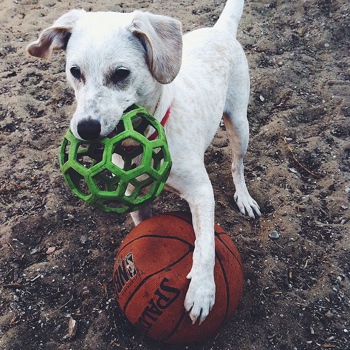Labraheeler

A cross between the docile, easy-going Labrador Retriever and the intelligent, hard-working Australian Cattle Dog, the Labraheeler makes a lovely pet for an active household. They benefit from good training and socialisation and would not be happy if left home alone during the day, preferring to be outside and doing things. With a great work ethic, these dogs can do well at practically anything they set their ‘paw’ to.
The smiling face of the Labraheeler complements their intelligent eyes and there is no question that they are a handsome breed. Many will have triangular ears that fold down, though some will retain the characteristic erect ears of the Australian Cattle Dog. Fur is short and typically brown and white or black and white but can be many number of different colour combinations.
About & History
The true beauty of the designer dog movement is that any combination of pedigree dog you think of is possible! The Labrador Retriever and Australian Cattle Dog were likely first mixed together some time in the last 30 or so years, though the first crossings were never documented. As both breeds are similar in size with an appearance that does not differ all that dramatically, there is already a uniformity appearing in the newly formed Labraheeler breed.
The Labrador Retriever
The Labrador Retriever is one of the most successful dog breeds of all time and tops the ‘Top Five Dog Breed’ lists internationally practically every year. Their popularity as a pet is not only down to their gentle nature but also because of the love and affection they show their families.
Though many assume that this breed hails from region of Labrador, they are actually originally from Newfoundland. Newfoundland dogs were crossed with local water dogs in the aim of creating a competent retriever that could bring prey back from the water, as well as from land. It was not until the early 1800s that this breed was brought to the UK. Since then, they have enjoyed great success both as gun dogs and as family pets. Though the original Labradors were all black, over time, yellow and chocolate coats became accepted.
The Australian Cattle Dog
The Australian Cattle Dog can be traced back to the early 19th century. Around this time, a large number of English cattle farmers emigrated to Australia and they quickly found that their home-bred dogs were not suited to the climate and were unable to work to a high standard. Farmers worked hard to create a new breed that would suit their purposes and withstand the harsh Australian climate. They bred a local Smooth Collie dog with a native Dingo, resulting in a breed referred to as Hall’s Heelers.
Over time, other breeds, such as the Australian Kelpie and the Dalmatian, were bred into the mix. Thus, by the late 1800s, the Australian Cattle Dog was created, which was a canine that resembled a Dingo but was far more tame and worked well around other animals. Initially, the breed was called the Australian Heeler and this name has stuck with them to this day.
Appearance
Both parent breeds have quite similar well-muscled, solid bodies and are medium in size. The Labraheeler tends to have a broad forehead and well set apart eyes with ears, which either stand erect like their Australian Cattle Dog parent, or flop to the sides of their face like their Labrador parent. Their eyes can be blue, green or brown and portray a calm and intelligent expression.
Once fully-grown into adults at about the age of one, a Labraheeler will measure from 45cm to 51cm and will weigh between 18kg and 30kg. The fur of the Labraheeler is quite short and straight and can come in a multitude of colours, including yellow, brown, blue, white, brindle and black. Many will be more than one colour and will have spots and markings, making them quite distinctive from their Labrador parents, who are renowned for only every having one block fur colour.
Character & Temperament
A real ‘dog’s dog’, the Labraheeler loves to run about, get muddy and play games. They make superb family pets as long as owners have the time available to spend with them. As with their Labrador parent, the Labraheeler is known to have a good nature and will bond closely with their family, having no issue showing them affection. Their loyalty for their family means that they would be willing to protect them and can make good watch dogs.
As long as they receive adequate socialisation, they should take to new people and other dogs well, though may take a few minutes to warm up to them. After a short period however, they will likely be playing with the new arrival as if they have known each other their whole lives! Though good with children, they do need to be monitored as they can get over-excited and may play too rough for little ones. While typically good with other dogs, the Labraheeler may treat some smaller pets as prey so supervision is wise.
Trainability
Eager to learn, food-driven, smart and biddable, the Labraheeler makes a wonderful dog to train. Consistency is key here and in good hands they can go a very long way. The fact that they are athletic dogs also helps, as they do not tire quickly and can continue with the same training exercise happily for hours on end.
As some dogs can be a little stubborn, trainers should set boundaries and ground rules from day one and should continue to reward correct behaviour throughout the dog’s life. Sensitive at times, punishment or negative reinforcement training is not advised.
Health
There are several health conditions to monitor for in this new cross-breed and breeders should use all of the available screening tools to ensure only the healthiest of parents are bred from.
Hip Dysplasia
In some ways, the Labrador Retriever is the ‘poster boy’ for Hip Dysplasia with a high proportion of Labs being affected. As the Australian Cattle Dog is also prone to this orthopaedic condition, it is little wonder that the Labraheeler can suffer too. It is vital that breeders take advantage of the screening tests on offer and ensure that they are not breeding from parents with poor hips.
Epilepsy
Dogs can develop epilepsy at any age but most will be less than five years old when they have their first fit. For some, it is triggered by something (such as a stressful event), but for others, it will occur seemingly out of the blue. When a dog has a fit, the vet will want to rule out any other potential causes, such as a toxin ingestion, liver disease or low blood sugar.
They may want to run a number of tests, including blood tests and brain scans. Dogs diagnosed with epilepsy will usually be managed with life-long medication and can go on to live relatively normal lives.
Hypothyroidism
An underactive thyroid is a medical condition whereby dogs do not produce enough thyroid hormone. This may either be due to lymphocytic thyroiditis (an immune disorder in which the thyroid gland is ‘attacked’ by the dog’s own body) or idiopathic thyroid atrophy (whereby the thyroid gland shrinks away and the functional tissue is replaced with fat cells). Luckily, the treatment of this condition tends to be very successful and the prognosis is excellent.
Exercise and Activity Levels
Given the working background of both parents, it is easy to guess the exercise requirements of the Labraheeler. Active dogs that love to be given something to do, these guys are happiest when hiking, jogging, swimming or working. Ideally, they will be given tasks to do that both stimulate their bodies and their minds. Excelling in a number of activities, such as agility and Flyball, this hybrid is one sporty dog.
If an owner is unable to provide at least one solid hour of exercise each day, they should consider a different breed. Labraheelers should not be confined to small homes and would ideally live somewhere rural where they can roam about and burn off calories throughout the day. Obesity can become a real issue in under-exercised individuals.
Grooming
The short fur of the Labraheeler is not too hard to maintain and can be brushed roughly twice a week to keep it in good condition. Breed members will shed a moderate amount, with shedding being heavier in certain seasons. Those dogs with floppy ears should have their ear canals cleaned out weekly to avoid infection.

